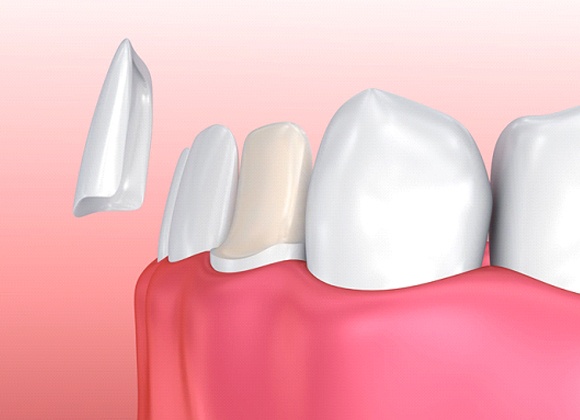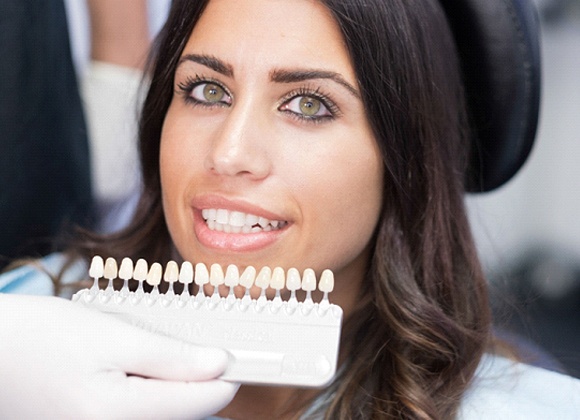Porcelain Veneers – Waverly, IA
Completely Transform Your Smile
Maybe you have teeth that look less than stellar, whether that be from chips, cracks, stains, gaps, or other minor cosmetic flaws. Sounds like you could benefit from porcelain veneers in Waverly. Dr. Smiley can bond these ultra-thin sheaths of durable dental porcelain to the front-facing surfaces of your pearly whites to mask all kinds of imperfections. In just two quick appointments, we can completely transform your smile. Contact us today to schedule a consultation to see if porcelain veneers are right for you.
Why Choose Smiley Family Dentistry for Porcelain Veneers?
- Look Completely Lifelike
- Correct All Kinds of Imperfections
- Can Last for Over a Decade
What Are Porcelain Veneers?

Veneers are wafer-thin porcelain shells that are attached to the front surfaces of your teeth to conceal just about any kind of cosmetic flaw you could have, like cracks, chips, and discoloration. In fact, porcelain veneers are often called “instant orthodontics” because they can quickly correct slightly crooked or rotated teeth, or close small gaps.
How Do Porcelain Veneers Work?

As mentioned earlier, the veneers process takes two appointments, after the initial consultation. At the first visit, Dr. Smiley will remove a tiny sliver of enamel from your teeth to ensure the veneers lay flush against them. Then, he will take impressions of your prepped teeth and send those off to the dental lab. In the meantime, we’ll fix you with temporary veneers that allow you to take your new and improved smile for a test drive.
You’ll return to our dental office in a few weeks when your permanent veneers are ready. We’ll simply attach them to your pearly whites, and ta-da! Your smile is instantly transformed into perfection.
Benefits of Porcelain Veneers

Veneers are a much more conservative treatment than other options like dental crowns, as they require much less enamel removal. Once enamel is gone, it’s gone for good, so you want to keep as much as possible.
Additionally, veneers are significantly more resistant to discoloration than natural tooth enamel. As long as you brush your teeth after enjoying a dark beverage like coffee, tea, or wine, you won’t have to worry about them staining your veneers.
Veneers are a great way to boost your self-confidence by perfecting your grin. They’re also incredibly easy to maintain. Simply brush and floss every day as you would your normal teeth. You’ll also need to come in every six months to see Dr. Smiley for a checkup and cleaning.
How to Know If Veneers Are Right for You

Before we can place veneers, we’ll have to make sure your teeth and gums are in good condition. This means any underlying issues like cavities and gum disease will need to be treated first. Furthermore, you’ll have to have plenty of tooth enamel left to give the veneers a good bonding surface. If there isn’t enough enamel left, the veneers basically won’t have anything to stick to, and you won’t be able to receive them.
If your teeth and gums are disease-free, and you have enough enamel left, then porcelain veneers might be just what you need to get the smile of your dreams!
Veneers FAQs
How Do Veneers Differ from Dental Crowns?
While veneers and dental crowns are both dental prosthetics, they aren’t exactly alike. They have different designs and play differing roles in your smile’s condition.
Dental crowns are basically protective caps for weakened teeth. Each covers a damaged tooth’s visible portion, defending it from harm as a result. That means a crown’s main role is to keep your teeth intact; any cosmetic benefits are secondary.
On the other hand, veneers are thin shells set on the fronts of teeth. Their purpose is purely cosmetic – they hide your smile’s flaws beneath a layer of porcelain or ceramic. Unlike dental crowns, they won’t stop bacteria and other forces from wearing down your smile.
What Happens to the Teeth Under Veneers?
Your teeth must be “prepped” before they get veneers; treatment won’t work otherwise. For that process, a dentist removes small bits of their enamel before placement.
Rest assured that the preparation work won’t harm your smile. It only shaves away a tiny amount of enamel, so it doesn’t damage your oral health. The bonding material it applies is also non-toxic and completely safe. Plus, the final veneers will cover the shaved areas to prevent any tooth sensitivity.
All that said, the teeth under veneers still need regular care. You’ll need to brush and floss often to keep them from decaying or getting infected. Similarly, you’d be wise to limit your sugar intake and get dental checkups every six months.
Is It Painful to Get Veneers?
Despite the prep work involved, veneer treatment shouldn’t cause any pain. Dentists (and their teams) take every step to ensure the process is smooth and easy.
You see, the dentist will numb your mouth before the preparation phase. This setup ensures you won’t feel aches as they work on the to-be-treated teeth. At most, you’ll only sense some pressure as they shave off some of your enamel.
Any veneer discomfort should only occur during the post-treatment phase. At that time, some patients may report “bonding sensitivity” – a sharp pain from biting into something hot or cold. This effect is temporary and can be managed with painkillers; it’ll fade after a few days.
How Long Do Veneers Last?
Veneers tend to last a while compared to other cosmetic dental services. Their average lifespan tends to sit around 15 years or so, though the exact number varies from patient to patient.
Of course, veneers can fail early if they aren’t given proper care. They’ll easily chip, crack, or fracture from bad oral habits or need removal due to underlying tooth decay. In other words, you’ll need to be careful with the shells once you get them.
To help your veneers last as long as possible, use the following tips:
- Remember to brush your teeth twice daily and floss between them once daily.
- Avoid bad oral habits like biting hard objects (ice, fingernails, etc.), smoking, or using your teeth as tools.
- See your dentist for dental checkups at least every six months or so.
